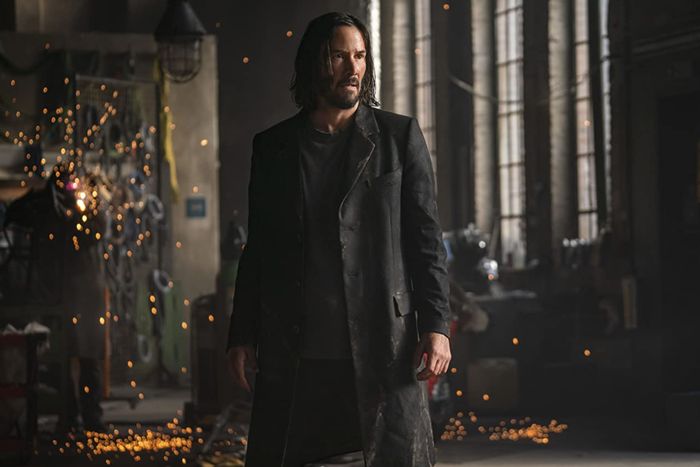
After all this time, what does the blockbuster have left to offer? At its platonic ideal, a big-budget, mass-marketed movie induces pleasure. With swift and bright characterization, it allows actors to operate in a grander register, aching to fill the space of dizzying visual landscapes around them. Bombast and awe on all fronts. Maybe it’s difficult to identify an ideal blockbuster in contemporary Hollywood, drawn as it is to weak craft, characters with little interior dimension, and an understanding of representation that reduces gender, race, and sexuality to items on a marketing checklist rather than world-building attributes of a story. This is the cinematic reality into which The Matrix Resurrections enters, over 20 years after its original incarnation debuted in 1999: A universe laden with sequels and reboots and constantly updated IP. A universe in which imagination has curdled into what can most easily be bought and sold. And yet here is Lana Wachowski, pushing back against the tired form and offering audiences something fresh, curious, and funny as hell.
Teetering between a meta-reckoning with the legacy of the first trilogy and a sincere blooming of a whole new story that feels boldly romantic, Lana Wachowski’s first solo feature is a thrilling triumph. It is impossible to overstate the influence of the previous three movies — particularly 1999’s The Matrix — on American culture, launching “red pill” into dark internet circles, prompting the kids I grew up with to nonchalantly wear latex and leather in the Miami heat, forcing action films of its time to claw upward in the direction of the Wachowski sisters’ cyberpunk-inflected aesthetic, which itself pulled from a wild array of influences. The world has changed dramatically since Neo first bent out of the way of incoming bullets, and yet The Matrix Resurrections easily makes a case for its own existence. After decades of audiences attempting to slot the franchise into one category of interpretation or another, the film argues against any imagined binary to show that beauty is found between such extremes. Wachowski builds on what of the greatest and most singular aspects of the original trilogy: its queerness.
Playing with ideas of memory and nostalgia could have led Resurrections to have a self-satisfied, airless quality. Instead, it feels emotionally expansive and intellectually sly. Much of the first act works to actively critique nostalgia for nostalgia’s sake, and how it is exploited by those in control, whether machine overlords or Hollywood studios. (“Nothing comforts anxiety like a little nostalgia,” Yahya Abdul-Mateen II’s Morpheus says.) Resurrections is messy and imperfect, too, often eschewing easily digestible plotting in favor of an ambitious eccentricity, a reminder that bombastic storytelling is best translated by artists who are willing to fail. From the revelatory production and set design to the warmth of the cinematography by John Toll and Daniele Massaccesi to the updated action scenes, Lana Wachowski proves how powerful a blockbuster can be in the hands of those with vision and ambition. But it’s the kind of film whose very foundation makes it tricky to discuss in depth without tracing the narrative and emotional shape of it. I recommend going into the film with an open heart, an open mind, and little knowledge of the nitty gritty turns in the story, some of which I’m about to examine. You’ve been warned.
Early in the film, inside a slick high-rise office overlooking the nearly too-perfect San Francisco skyline, a gaggle of video game developers argue about what the Matrix is an allegory for. Is it trans rights and politics? Is it capitalist exploitation? The scene has a rhythmic dexterity, as the developers volley forth opinion after opinion. It’s poised to be hilarious, and it is. Among the developers is Thomas Anderson (Keanu Reeves), who in this new world is a famous video-game designer who created a game called The Matrix to much acclaim. He’s a suicide survivor, having once lept from a building on a clear sunny day believing he could fly. When his business partner (Jonathan Groff) says he must design a new Matrix game despite his vowing not to, his reality starts to slip. Is he losing his mind or is the Matrix he supposedly created something more than a game?
Wachowski and co-writers David Mitchell and Aleksander Hemon play out this anxiety with a consistent intrusion of clips from the previous films, a strategy that doesn’t always work. But when it does, it’s sublime. Like in the scene where Thomas Anderson slips from this therapist’s (Neil Patrick Harris) grasp and realizes he is indeed the Neo of his video game. His memory of meeting Morpheus (Lawrence Fishburne then, Abdul-Mateen II now) is projected onto a ripped projector screen that acts as a doorway, figuratively and literally. Freed from a prison once again, Neo learns it has been 60 years since he and Trinity (Carrie-Anne Moss) traveled to the machine city, sacrificing their lives for their revolutionary cause. He must determine: Can he free Trinity, too, or is she happy in this false new world where she is a married mother of two with a penchant for motorcycles? Neo never truly believed in himself as the One, but Trinity did. How can he be what everyone believes him to be without her?
The Matrix Resurrections might lack the ground-shaking originality of its 1999 predecessor, but it manages to chart a stunning, divergent path, philosophically and cinematically. Whereas the previous Matrix films were committed to a green-dominated, cool-toned color palette, Resurrections simmers with far greater warmth — amber-hued sunlight streaming through the real world. The fight choreography, from John Wick’s Chad Stahelski (Reeves’s Matrix stunt double, who plays Trinity’s husband in the new film), is more chaotic and rough-hewn; bodies crash into one another haphazardly, lacking the grace and fluidity Yuen Woo-ping brought to the original movies. The costume design led by Lindsay Pugh brings back gothic sensibilities with restraint, forgoing fetish wear but remaining committed to the epic-ness of flowing silhouettes. The sets are littered once again with mirrors that glisten with thematic resonance. The film commits to granting audiences joy in ways that feel primal (exceedingly hot, well-dressed people are kicking unholy amounts of ass) and earnest (Wachowski does not abandon the previous films’ core belief in hope and community building).
That joy emanates through the cast. Harris’s naturally haughty, self-satisfied miasma works perfectly. Groff is cheeky and charismatic as a rebooted version of Agent Smith, his fight scene with Neo in an abandoned building being one of the highlights of the film. Decked in finely tailored suits the color of marigolds and deep ocean waters, Abdul-Mateen II slinks and struts with the grace of a true movie star, winking at Morpheus’s love of theatrics. (The fact that Fishburne wasn’t asked to be a part of the franchise rebirth hangs over the performance, though.) Jessica Henwick exudes hope, grounding the unexpected coalition that pins the movie together. The new actors, even when they’re playing old characters, are so much more than energetic doppelgängers of the Matrix heroes and villains who came before them, absorbing well the aesthetic differences between this reboot and the trilogy.
But for all its strengths — retreading and remixing the franchise while charting a bold new course for the canon — The Matrix Resurrections would fail if it wasn’t for the chemistry of Reeves and Moss. The former has by now solidified his place as a major movie and action star several times over, seamlessly moving from tickled bewilderment to sincere fear to absolute control on screen. Watching Moss, with her cutting gaze and sharp physicality, I can’t help but mourn for the career she deserved. Together, there is an inherent optimism — about the human spirit, about the will to overcome a narrowing force — that flits open when they share a scene. It’s along the arc of Neo and Trinity’s romance that Resurrections separates itself from its recent blockbuster brethren. Behind a meta-narrative storytelling approach and all that stylistic gleam, The Matrix Resurrections is ultimately a love story — romantic, yes, and a paean to the community necessary for that romance to blossom into resistance. Wachowski is bold enough to argue that in a strategically queer-fashioned world, where boundaries break and the limits of the human body are rejected, choosing love is still a radical decision.





